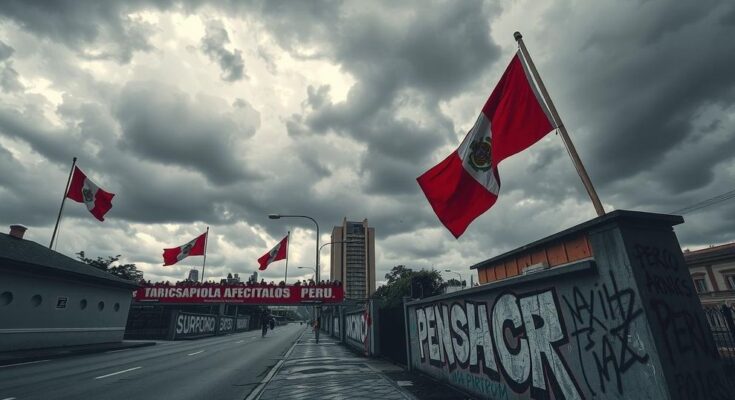Peruvian President Dina Boluarte faces one of the lowest approval ratings globally at two percent while navigating scandals and protests. Despite her unpopularity, political analysts suggest Congress may keep her in power due to lack of viable alternatives. Ongoing investigations and the economy’s resilience complicate dynamics as Peru inches closer to her term’s end.
Lima (AFP) – Peruvian President Dina Boluarte is facing an unprecedented level of unpopularity with an approval rating plummeting to just two percent, possibly making her one of the world’s least favored political figures. Despite this dire situation, Boluarte persists, managing to navigate through turmoil marked by scandals, mass protests, and several ongoing investigations. This is deeply noteworthy given her precarious position in a politically unstable environment.
Since Boluarte’s ascension to the presidency, which occurred 29 months ago, she has been met with protests reflecting deep discontent. Scandals surrounding alleged military repression, luxury gifts, and cosmetic surgery only intensify her challenges. Analysts suggest that voter indifference and a politically advantageous Congress might allow Boluarte to complete her term until July next year, defying the trend of Peru’s frequently ousted leaders. Political analyst Augusto Alvarez from the University of the Pacific remarks, “In Peru, there is a political paradox: Boluarte is the weakest president of the last decade. But her weakness is also her strength.”
Interestingly, Congress may favor her fragility, leveraging it to strengthen their own positions while passing laws benefiting their allies. In light of ongoing political instability, Peru has cycled through six presidents in the past eight years, and should Boluarte remain in office, she would claim the title of the longest-serving leader among them. Taking over after the impeachment and imprisonment of former president Pedro Castillo, Boluarte chose not to call immediate elections, opting instead to step into the presidential role herself.
Boluarte has amassed a series of controversies; she currently faces a dozen investigations linked to various issues, including a police crackdown that resulted in the deaths of fifty protesters post-Castillo’s removal. Additional scrutiny is directed at her mishandling of luxury gifts in the now-infamous “Rolexgate” and her poorly timed absence for rumors of cosmetic surgery. Reflecting her diminishing popularity, Ipsos polling recently recorded a low of two percent approval, a remarkable drop from the 21 percent rating she initially held upon taking office. Alfredo Torres, president of Ipsos Peru, commented, “We might be talking about a world record of sustained presidential disapproval.”
On a more positive note for Boluarte, Congress seems to keep her in place largely due to their search for a viable candidate, as her weakness allows them to pass beneficial legislation without significant opposition. Transparency International’s Peruvian chapter, Proetica, has criticized Congress for undermining anti-corruption reforms and sidestepping ethical scrutiny. Furthermore, the Peruvian economy appears to be holding up quite well, with an impressive GDP growth rate of 3.3 percent last year and 3.9 percent spurred in a strong showing for the first quarter of 2025.
Many observers note that this economic success may not result from Boluarte’s policies but rather from external factors, such as a rise in global copper prices, a critical product for the country. On the streets, however, public sentiment towards Boluarte is largely negative amid a rising tide of gang-related violence and extortion killings. Saturnino Conde, a local teacher, criticized the president, stating, “She has no empathy, she is an incapable president; she does not solve the security problem.”
Even so, experts consider a full-scale uprising unlikely. Peruvian citizens seem to believe it would be futile to push for her resignation or ousting, due in part to the equally poor image of Congress. Ipsos manager Torres pointed out that “there is no other candidate that captivates” the public, which leads to a hesitancy in removing her from office.
In conclusion, while Boluarte’s regime is beleaguered by widespread disapproval and governance challenges, both political dynamics and economic factors play significant roles in her ability to maintain power. Peruvians appear to feel locked in a cycle of disappointment and political inefficacy, which has stifled any widespread movement toward upheaval against her administration. This creates a complex and fraught political landscape as Peru edges closer to the end of her term next year.
Peru’s President Dina Boluarte stands out, not just for her low approval rating but for the complexities underpinning her administration. Despite unrest and significant scandals, her survival hinges on Congressional dynamics and an uneven economy. The lack of viable alternative leaders seems to contribute to her tenuous grip on power, even amid a populace deeply critical of her leadership. It leaves Peru in a precarious position as it approaches the conclusion of her term.
Original Source: www.france24.com




